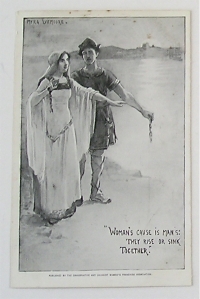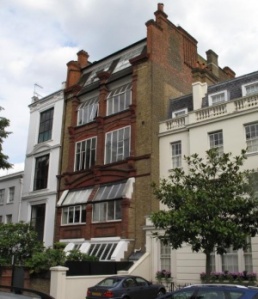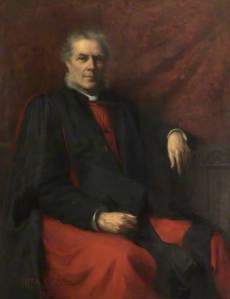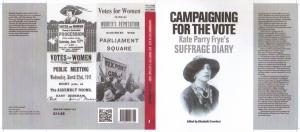Posts Tagged gerard manley hopkins
Kate Frye’s Suffrage Diary: Myra Luxmoore, Suffrage Artist
Posted by womanandhersphere in Kate Frye's suffrage diary, Uncategorized on February 4, 2013
I first came across mention of ‘Miss Luxmoore’ in the pages of Kate Frye’s diary. Obviously a suffragist, with a Studio at 57 Bedford Gardens, Campden Hill, I presumed she was an artist. But who was she? Her name is not recorded in, for instance, Lisa Tickner’s Spectacle of Women, the vademecum on suffrage artists. Intrigued, I thought it worth finding out more about Miss Luxmoore and her world.
So, to begin at the beginning, here are three entries from Kate Frye’s diary in which she records meetings held at Miss Luxmoore’s Studio.
Tuesday February 9th 1909
Dinner at 7.30. Off at 8 o’clock to Bedford Gardens – Miss Luxmoore’s Studio to a Suffrage meeting. Got there in good time and started to work at once stewarding and trying to make converts. Got a young man student to join the Men’s League. Mr Mitchell and Miss Clementina Black were the speakers and did very well. Alexandra [Wright] was in the Chair. I waited at the end helped count the money etc and walked up to Notting Hill Gate with the Wrights and Miss Black and walked all the way home. Was not in till after 11 o’clock. Very much enjoyed the meeting and the Suffrage atmosphere and meeting all those students was like a page out of a book.
Tuesday March 30th 1909
I changed my dress had a bit of something to eat then off at 7.30. Walked to Richmond Road took a bus to Bedford Gardens and went to Miss Luxmoore’s Studio Suffrage meeting. Gladys was there. Mrs Graves took the chair. Miss Meyer helped and Mrs Stanbury spoke – but, besides ourselves, there were only 15 audience. Mrs Henry of the Camden Institute was there. I had sent her a card and she quite disgraced herself and made Mrs Stanbury very uncomfortable by hissing loudly, then walking out with her poor unfortunate daughter. Something Mrs Stanbury said upset her – she was only talking history but Mrs Henry took it to mean the Queen of Spain – but I could not understand it till I got home and found from Daddie that Mrs Henry has become a ‘pervert’ to the Roman Catholic Church. It made a nasty impression on us somehow. We had a chat afterwards and all got very low spirited. There has been another raid on the House – several arrests and the women much knocked about – it is all so awful.
Tuesday May 4th 1909
Went off at 7.30 [pm] Walked to Richmond Road – a bus from there to Bedford Gardens – and to Miss Luxmoore’s Studio for a Woman’s Suffrage meeting. Such a crush of people and no end of helpers. Mrs Carl Hentschel, Miss Abadam and Mr Walter McLaren were the speakers. Miss Hentschel [her father, Carl Hentschel, was a lithographic printer, responsible for some suffrage posters], Miss Porter, Miss Meyer and, of course, Gladys and Alexandra. I had sent Miss Lockyer [who had been the late William Whiteley’s housekeeper] a ticket and she was there with Miss Clara Whiteley – and who should be there but one of the Miss Hollingsworths (Jessie) taken by some friend. I made three members – which wasn’t bad – and I waited with the others to help clear up and walked to Notting Hill Gate with them. Then came home in a bus. Was so tired. Mother was waiting up. Supper & bed. Mrs Carl Hentschel’s maiden speech and she did it very well and I don’t think I ever heard a more rousing speech than Miss Abadam. Mr McLaren [Walter McLaren, Liberal MP] was stupid.’
My research has shown me that ‘Miss Luxmoore’ was Myra Elizabeth Luxmoore (1860-1918), born in Paddington, the only child of John and Jane Luxmoore. By her first marriage, however, Jane had at least three daughters, Myra’s elder half-sisters. John Luxmoore worked for the Great Western Railway as a superintendent locomotive engineer. After a period based in Paddington, the family followed John’s work to Newport in south Wales and finally to Newton Abbot in his native Devon.
By 1888, giving her address as Somerford, Newton Abbot, Myra Luxmoore was exhibiting as an Associate with the Society of Women Artists. By 1891 she had moved to London and was living at 32 Charlotte Street, Fitzroy Square. She then spent a brief time living at 87 Cadogan Gardens before moving, c 1905, to her studio at 57 Bedford Gardens. After that she began exhibiting regularly at the Royal Academy. Around 1912 Myra Luxmoore moved to 80 Redcliffe Square, Kensington, remaining there until her death in 1918.
You can see from the photograph (above) that 57 Bedford Gardens had been purpose-built with artists in mind, with large windows to provide ample light. A google search shows photographs of the inside of the apartments as they are today – lofty spaces, providing ample room for a suffrage meeting.
When researching suffrage boycotters of the 1911 census I was interested to note that, while the enumerator wrote in his book that Myra Luxmoore was the occupier of a studio at 57 Bedford Gardens, he marked the apartment as unoccupied on census night. Presumably she, along with several other of the artists who shared the address, had opted to spend the night elsewhere. Her distinctive name is to be found nowhere else in the census returns.

Myra Luxmoore’s card published by the Conservative and Unionist Women’s Franchise Association (photo courtesy of Ken Florey)
I had wondered where Myra Luxmoore’s suffrage allegiances lay and have recently discovered this card (left) illustrated by her and published by the Conservative and Unionist Women’s Franchise Association. I think, therefore, it would not be too far-fetched to think that she was a supporter of the CUWFA. Incidentally, as far as I remember, this is the only postcard issued by the CUWFA that I have ever seen.
The majority of Myra Luxmoore’s exhibited works bear rather wispy titles – such as ‘Roses and Sweet Lavender’, or ‘What’s O’Clock?’ – although a few portraits are noted. One such was the portrait of Norah, the 18-year-old daughter of Sir John Craggs MVO, exhibited at the Royal Academy in 1913. By 1910 another of Sir John’s daughters, Helen, was a full-time paid organiser for the WSPU. This was most definitely not a career move of which her father approved and I wonder if he would have commissioned the portrait if he had known that the artist had strong suffrage – although not militant – sympathies? [Incidentally Helen Craggs in 1957 married, as her second husband, the widowed Lord Pethick-Lawrence.]
One portrait by Myra Luxmoore is known to hang in a public collection, that of the Very Rev Edward McClure (1833-1906), Dean of Manchester.
Other of her works were collected by Mother Agnes Mason, Foundress of the Community of the Holy Family. Click here to read about her connection with Myra Luxmoore and her works. The article also gives some, unverified, information about the Luxmoore family’s friendship with the family of Gerard Manley Hopkins.
Campaigning for the Vote: Kate Parry Frye’s Suffrage Diary edited by Elizabeth Crawford
For a full description of the book click here
Wrap-around paper covers, 226 pp, over 70 illustrations, all drawn from Kate Frye’s personal archive.
ISBN 978 1903427 75 0
Copies available from Francis Boutle Publishers, or from Elizabeth Crawford – e.crawford@sphere20.freeserve.co.uk (£14.99 +UK postage £3. Please ask for international postage cost), or from all good bookshops. In stock at London Review of Books Bookshop, Foyles, National Archives Bookshop.


